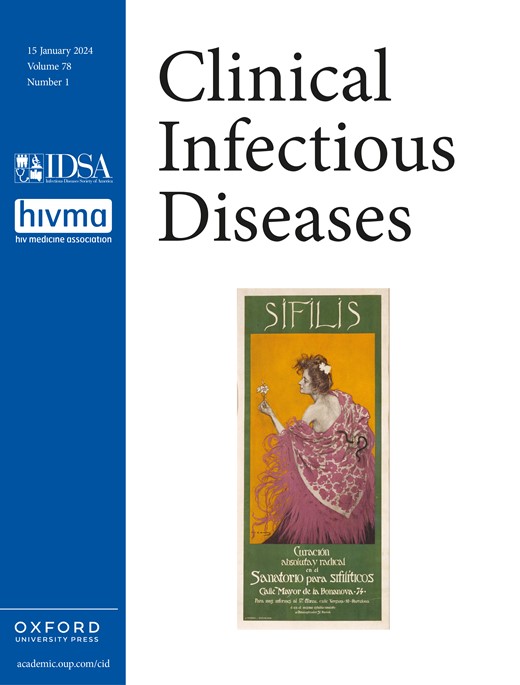流感对美国工作年龄成年人的影响:探索重组流感疫苗的益处
IF 8.2
1区 医学
Q1 IMMUNOLOGY
引用次数: 0
摘要
尽管美国普遍推荐流感疫苗,但工作年龄成年人(18-64岁)的疫苗接种率(VCR)仍不理想。研究表明,重组流感疫苗(RIV)比标准剂量灭活流感疫苗(sd - iv)在这些年龄段提供更好的保护。我们探讨了向美国工作年龄人口推荐RIV的潜在附加好处。方法收集美国疾病控制与预防中心(2012-2023年,不包括2020-2021年)的流感负担、疫苗有效性和VCR数据。我们对过去10年进行了回顾性分析,以说明18-64岁成年人的流感负担。我们使用慢性疾病的患病率进行了年龄分层分析,以评估其对流感住院和死亡的影响,并使用年龄和风险组决策树模型估计在研究期间使用RIV而不是sd - iv的住院减少。在过去十年中,流感导致美国工作年龄成年人每个季节中位数为151,021例住院(95% CI 139,750-164,130)。50-64岁的成年人的住院率和死亡率比18-49岁的成年人高3- 5倍。18 - 49岁的慢性病患者占14%,占该群体住院和死亡人数的28%以上。如果使用RIV而不是sd - iv,在这些人群中,每个季节可以避免额外的10,000例住院治疗。流感对美国工作年龄的成年人影响显著,尤其是50-64岁的成年人。预期寿命和慢性病患病率将会增加,因此有针对性的公共卫生疫苗建议对于支持健康老龄化至关重要。本文章由计算机程序翻译,如有差异,请以英文原文为准。
The Impact of Influenza on US Working-Age Adults: Exploring the Benefits of the Recombinant Influenza Vaccine
Background Despite universal influenza vaccine recommendation in the US, vaccination coverage rates (VCR) in working-age adults (18–64 years) remain suboptimal. Studies have suggested that recombinant influenza vaccines (RIV) offer better protection than standard-dose inactivated influenza vaccines (SD-IIV) in those ages. We explored the potential added benefit of recommending RIV for the US working-age population. Methods We gathered data on influenza burden, vaccine effectiveness, and VCR from the US-CDC (2012–2023, excluding 2020–2021). We conducted a retrospective analysis of the past 10 years to illustrate the influenza burden among adults 18–64 years. We performed an age-stratified analysis using prevalence of chronic conditions to assess their impact on influenza hospitalizations and deaths, and estimated reductions in hospitalizations if RIV had been used instead of SD-IIV during the study period, using an age and risk-group decision-tree model. Results Over the last decade, influenza caused a median of 151,021 hospitalizations (95% CI 139,750–164,130) per season among US working-age adults. Adults aged 50–64 years had 3- to 5-fold higher rates of hospitalization and death than those aged 18–49 years. The 14% of 18–49-year-olds with chronic conditions accounted for more than 28% of hospitalizations and deaths in this group. If RIV had been used instead of SD-IIV, an additional 10,000 hospitalizations could have been prevented each season in these populations. Conclusions Influenza significantly impacts US working-age adults, particularly 50-64-year-olds. Increases in longevity and chronic conditions prevalence are expected, making tailored public health vaccine recommendations important to support healthy aging.
求助全文
通过发布文献求助,成功后即可免费获取论文全文。
去求助
来源期刊

Clinical Infectious Diseases
医学-传染病学
CiteScore
25.00
自引率
2.50%
发文量
900
审稿时长
3 months
期刊介绍:
Clinical Infectious Diseases (CID) is dedicated to publishing original research, reviews, guidelines, and perspectives with the potential to reshape clinical practice, providing clinicians with valuable insights for patient care. CID comprehensively addresses the clinical presentation, diagnosis, treatment, and prevention of a wide spectrum of infectious diseases. The journal places a high priority on the assessment of current and innovative treatments, microbiology, immunology, and policies, ensuring relevance to patient care in its commitment to advancing the field of infectious diseases.
 求助内容:
求助内容: 应助结果提醒方式:
应助结果提醒方式:


